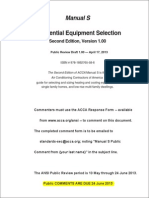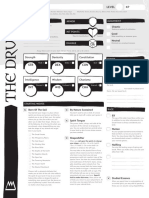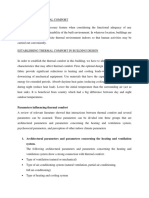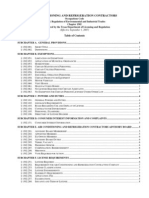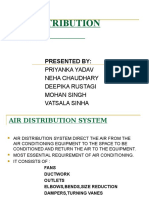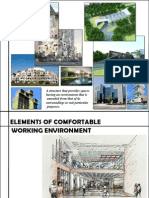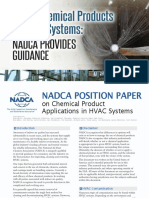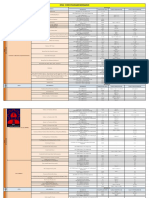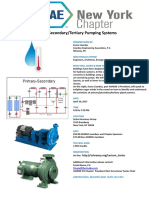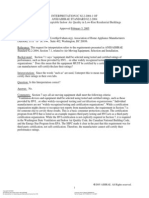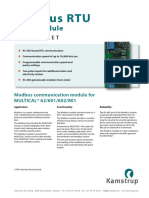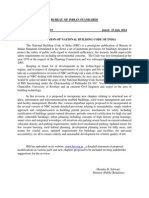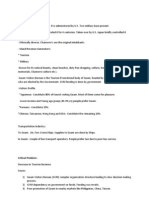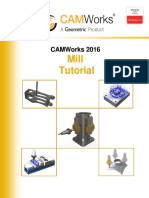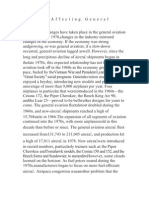ACCA 6 QR HVAC System Cleanliness RA 2021
ACCA 6 QR HVAC System Cleanliness RA 2021
Uploaded by
ridCopyright:
Available Formats
ACCA 6 QR HVAC System Cleanliness RA 2021
ACCA 6 QR HVAC System Cleanliness RA 2021
Uploaded by
ridCopyright
Available Formats
Share this document
Did you find this document useful?
Is this content inappropriate?
Copyright:
Available Formats
ACCA 6 QR HVAC System Cleanliness RA 2021
ACCA 6 QR HVAC System Cleanliness RA 2021
Uploaded by
ridCopyright:
Available Formats
ACCA Standard 6
AIR CONDITIONING CONTRACTORS
OF AMERICA
1330 Braddock Place STANDARD NUM BER: ANSI/ACCA 6 QR – 2015 (RA 2021)
Suite 350 (Reaffirmed in 2021 without changes)
Alexandria, VA 22314
703.575.4477
Fax 703.575.8107 Restoring the Cleanliness of
www.acca.org
HVAC Systems
Residential and Commercial Heating,
Ventilating, and Air Conditioning
(HVAC) Applications
The Air Conditioning Contractors of America Educational
Institute (ACCA-EI) Standards Task Team (STT) develops
standards as an American National Standards Institute (ANSI)
accredited standards developer (ASD). ACCA develops
voluntary standards as outlined in the ACCA Essential
Requirements and the ANSI Essential Requirements. ACCA
standards are developed by diverse groups of industry
volunteers in a climate of openness, consensus building, and
ACCA Standards are updated lack of dominance (e.g., committee/group/team balance).
on a periodic basis. The date Essential requirements, standard activities and
following the standard number
is the year of approval release documentation can be found in the standards portion of the
by the ACCA-EI Standards Task
Team. The latest copy may be
ACCA website at www.acca.org. Questions, suggestions, and
purchased from the ACCA proposed revisions to this standard can be addressed to the
online store at www. acca.org
or ordered from the ACCA attention of the Standards Task Team, ACCA, 1330 Braddock
bookstore via toll-free Place, Suite 350, Alexandria, VA 22314.
telephone at 703.575.4477.
DISCLAIMER AND LEGAL NOTICE
This Standard and all earlier working/review drafts of this Standard are protected by copyright. By making this
document available for use and adoption by public authorities and others, ACCA does not waive any rights in
copyright to this document. No part of this Standard or earlier working/review drafts of this Standard may be
reproduced, stored in a retrieval system, or transmitted in any form by any technology without permission from ACCA.
Address requests to reproduce, store, or transmit to the ACCA offices in Alexandria, VA.
© 2021, Air Conditioning Contractors of America
1330 Braddock Place, Suite 350
Alexandria, VA 22314
Adoption by Reference
Public authorities and others are encouraged to reference this document in laws, ordinances, regulations,
administrative orders, or similar instruments. Any deletions, additions, and changes desired by the adopting authority
must be noted separately. The term “adoption by reference” means the citing of title and publishing information only.
Disclaimer and Legal Notice
Diligence has been exercised in the production of this Standard. The content is based on an industry consensus of
recognized good practices. The commentary, discussion, and guidance provided by this publication do not constitute
a warranty, guarantee, or endorsement of any concept, observation, recommendation, procedure, process, formula,
data-set, product, or service. ACCA, members of the Standards Development Committee, Standards Task Group,
members of the Standards Task Team, and the document reviewers do not warrant or guarantee that the information
contained in this publication is free of errors, omissions, misinterpretations, or that it will not be modified or
invalidated by additional scrutiny, analysis, or investigation. The entire risk associated with the use of the information
provided by this Standard is assumed by the user.
ACCA does not take any position with respect to the validity of any patent or copyrights rights asserted in connection
with any items, process, procedures, or apparatus, which are mentioned in or are the subject of this document, and
ACCA disclaims liability of the infringement of any patent resulting from the use of or reliance on this document.
Users of this document are expressly advised that determination of the validity of any such patent or copyrights, and
the risk of infringement of such rights, is entirely their own responsibility. Users of this document should consult
applicable federal, state, and local laws and regulations. ACCA does not, by the publication of this document, intend
to urge action that is not in compliance with applicable laws, and this document may not be construed as doing so.
Nothing in this standard should be construed as providing legal advice, and the content is not a substitute for obtaining
legal counsel from the reader’s own lawyer in the appropriate jurisdiction or state.
ANSI / ACCA 6 – 2015 (RA 2021) (HVAC System Cleanliness)
ACKNOWLEDGEMENTS Page i
ACKNOWLEDGEMENTS
Special acknowledgment goes to the following individuals for their helpful input and guidance during the
2015 revision of the QR Standard:
Robert Baker, BBJ Consulting Service; Tampa, FL
Ron Bladen, ACCA; Arlington, VA
Luis Romeo Escobar, ACCA; Arlington, VA
Greg Long, IAQ Consulting Services; Temple, TX
Tom Yacobellis, DUCTZ National Service Team; Dunedin, FL
ACCA gratefully acknowledges the direction, guidance and encouragement provided by the diverse
expertise embodied in the membership of the 2007 System Cleanliness Standards Development Committee:
Robert Baker, BBJ Environmental Solutions Inc.; Tampa, FL
Robert Feather, B. F. Mechanical Heating & Air Conditioning; Centerville, OH
Glenn Fellman, Indoor Environment Communications; Rockville, MD
Carl Grimes, Healthy Habitats LLC; Denver, CO
Glenn Hourahan, ACCA; Arlington, VA
Fred Kahn, Guardian Services; Dallas, TX
Greg Long, IAQ Consulting Services; Temple, TX
Jeffrey Miller, Al-Don Service Inc.; St. Louis, MO
Patrick O’Donnell, EnviroTeam; Pompano Beach, FL
George Rodriguez, ServTEC Air Conditioning Inc.; Santa Fe Springs, CA
Larry Sambrook, Indoor Air Quality Network; Stanton, VA
Tom Yacobellis, DUCTZ Inc.; Dunedin, FL
Additional Supporting Staff:
Wesley R. Davis, ACCA; Arlington, VA
Warren Lupson, Lupson & Associates, Silver Spring, MD
Richard Shaw, ACCA; Arlington, VA
ANSI / ACCA 6 – 2015 (RA 2021) (HVAC System Cleanliness)
Page ii FOREWORD
FOREWORD
[This Foreword is not part of the Standard. It is merely informative and does not contain requirements necessary
for conformance to the Standard. It has not been processed according to the ANSI requirements for a standard
and may contain material that has not been subject to public review or a consensus process. Unresolved
objectors on informative material are not offered the right to appeal at ACCA or ANSI.]
Heating, ventilation, and air conditioning (HVAC) systems – recognized as being comprised of HVAC
equipment, components, subassemblies, and associated ducts and piping – are only one of many inter-
related systems in buildings responsible for providing comfortable and healthy indoor environments for
human occupants. Changes in one building system can affect the others, impacting the overall building
conditions and possibly affecting occupants’ acceptability of the indoor environment. All building systems
should therefore be properly maintained, both individually and in relation to the others.
As part of their normal operation, HVAC systems can accumulate considerable amounts of dirt, debris,
allergens, and other particulates over a period of time. The HVAC system operation often involves moisture
which can support the growth and colonization of bacterial and fungal microorganisms. These
microorganisms can accumulate or amplify throughout the HVAC system over time depending on a variety
of factors, including quality and location of air filters and other peripherals, maintenance schedules, and
the indoor/outdoor environmental conditions. HVAC equipment and systems containing excessive debris,
whether inert particles or microorganisms, have been shown to use more energy, distribute poorly
conditioned air, and accelerate degradation of system components.
This Standard is intended for restoring the cleanliness of HVAC systems. Although the procedures are also
designed to reduce an adverse effect on the indoor environment and other building systems, it is not intended
to be recognized as the sole remedy for resolving all indoor air quality concerns.
The need for cleaning may arise when the HVAC system operation has resulted in the buildup of particulate
and debris which may adversely impact the indoor environment and performance of the system. In such
cases, the HVAC system will require cleaning activities beyond those performed in normal HVAC
mechanical maintenance and servicing. This standard has been created to:
• Significantly improve the cleanliness of an HVAC system and return it to a reasonable serviceable
condition, although not necessarily to return the system to an “as new” condition.
• Allow the contractor and/or owner to determine if replacing certain components of the HVAC
system, or possibly replacing all of the HVAC system, is a more feasible approach versus
undertaking associated cleaning activities.
This Standard asserts that when any portion of an HVAC system is cleaned, the entire HVAC system also
must be considered for cleaning or replacement as well. The procedures within this document are designed
to be initiated in their entirety, in the sequence described herein, to achieve satisfactory system cleanliness.
It is recognized that a cleaned individual component can provide an improvement. However,cleaning single
components or subassemblies without considering the complete HVAC system could result in a degradation
of the indoor air quality. For example, the increased airflow from a newly-cleaned blower assembly can
disturb previously adhered particulates within both the supply duct and the return duct, resulting in the
release and subsequent distribution of undesired contaminants into the indoor environment.
This Standard acknowledges that HVAC systems could require considerable dismantling for proper
cleaning (e.g., removal of coil from the refrigerant circuit). The HVAC system restorer will need a level of
training and experience in order to perform the required procedures in accordance with this Standard,
applicable industry standards, good practices, and federal / state / local requirements. In many states, such
HVAC professionals and contractors may need to be licensed for these activities.
ANSI / ACCA 6 – 2015 (RA 2021) (HVAC System Cleanliness)
INTRODUCTION Page iii
INTRODUCTION
[This Introduction is not part of the Standard. It is merely informative and does not contain requirements
necessary for conformance to the Standard. It has not been processed according to the ANSI requirements for
a standard and may contain material that has not been subject to public review or a consensus process.
Unresolved objectors on informative material are not offered the right to appeal at ACCA or ANSI.]
This standard has been created using a procedural format to assure that restoring HVAC system cleanliness
yields maximum benefit with minimal impact on indoor air quality, building occupants, or the building
structure during the cleaning process. This Standard describes cleaning methods and procedures that focus
on improving the overall indoor air quality, existing equipment life, and safeguarding the building through
comprehensive restoration practices. This Standard also provides direction to assess the economic viability
of replacing HVAC components or systems versus cleaning them.
It is important to understand that the procedures within this document are not designed to be performed as
individual tasks (i.e., cleaning the ductwork alone or the HVAC unit alone), but should be initiated in their
entirety to assure the maximum benefit to indoor air quality and energy efficiency.
In order to address some procedures within this document, the HVAC system restorer may need to hold an
EPA refrigerant certification, be experienced in brazing and heat exchanger coil removal, understand wiring
schematics, and have a working knowledge of HVAC systems. HVAC units can be complex to dismantle
and reassemble, limiting the number of qualified individuals who can appropriately access the internal
components such as coils, drain pans, and secondary heat exchangers that collect and harbor significant
amounts of particulate. The process of cleaning ductwork without properly addressing other system
components may have little or no impact on improving the overall HVAC efficiency. Studies have
illustrated that a relatively small amount of collected particulate on cooling coils will dramatically reduce
efficiency. Collected particulate within the coil surfaces may also lead to possible microbial growth.
ANSI / ACCA 6 – 2015 (RA 2021) (HVAC System Cleanliness)
Page iv Table of Contents
TABLE OF CONTENTS
ACKNOWLEDGEMENTS ........................................................................................................................................... i
FOREWORD ................................................................................................................................................................ ii
INTRODUCTION ........................................................................................................................................................ iii
1.0 Purpose ................................................................................................................................................................... 5
2.0 Scope ....................................................................................................................................................................... 5
3.0 Establishing Criteria for HVAC System Cleaning .................................................................................................. 6
4.0 HVAC System Restoration Protocol ....................................................................................................................... 8
5.0 Post Cleaning Verification ................................................................................................................................... 14
6.0 Post Cleaning Products and Usage ....................................................................................................................... 15
APPENDIX A – HVAC MAINTENANCE, PERIODIC INSPECTIONS, CLEANING, BENCHMARKING ......... 16
APPENDIX B – GENERAL TOOL RECOMMENDATIONS .................................................................................. 20
APPENDIX C – DEFINITIONS ................................................................................................................................. 21
APPENDIX D – PERTINENT HVAC BIBLIOGRAPHY & RESOURCES ............................................................. 23
ANSI / ACCA 6 – 2015 (RA 2021) (HVAC System Cleanliness)
Page 5 PURPOSE / SCOPE
1.0 PURPOSE
This Standard establishes minimum requirements to restore the cleanliness of residential and
commercial HVAC systems in accordance with manufacturer- or customer-specified criteria.
The Standard defines minimum procedures and practices to:
a) Determine when airside surfaces should be cleaned, and when they require repair or
replacement.
b) Clean the airside surfaces within HVAC systems.
c) Control the spread of contaminants which may be released as a result of the HVAC cleaning
process.
d) Verify the cleanliness of HVAC systems.
2.0 SCOPE
2.1 The methodologies used in this Standard address the designed HVAC air pathways and
associated airside HVAC components such as evaporator fan sections, air ducts, and
components contained within HVAC systems.
2.2 Excluded from this Standard are the following:
a) Components or surfaces outside the design air pathway (e.g., condenser coils,
compressors, condenser fan motors, exterior duct and/or equipment surfaces, etc.).
These items should be maintained and serviced as required in accordance with the
ACCA 4 QM Standard (residential) and ACCA/ASHRAE 180 Standard (commercial).
b) Non-ducted, free air return- or supply-plenums (i.e., wall cavities, joisted floors, floor
or ceiling plenums, sub slabs, etc.).
c) The disturbance, cleaning, removal, abatement, or handling of any material regulated
by federal, state or local law, or considered by these agencies to be hazardous.
ANSI / ACCA 6 – 2015 (RA 2021) (HVAC System Cleanliness)
Page 6 ESTABLISHING CRITERIA FOR HVAC SYSTEM CLEANING
3.0 ESTABLISHING CRITERIA FOR HVAC SYSTEM CLEANING
Prior to initiating any cleaning activities, an HVAC contractor or an independent Indoor Air Quality
Consultant should determine the system cleaning needs and economic practicality of undertaking
restorative cleaning activities. This determination shall include a site survey of the building, a visual
assessment of the HVAC system’s components, the age of the components under consideration,
and an economic assessment of HVAC system cleaning versus equipment/component replacement.
This Standard requires the involvement of a third-party indoor environmental consultant when
correlations, or assertions, of HVAC system cleanlinessare linked to occupant health.
3.1 Minimum qualifications of HVAC inspector: In order to effectively undertake the
assessment requirements of this Standard, the HVAC inspection needs to be undertaken by
professionals that:
• Have a working understanding of an HVAC system’s internal components;
especially components that restrict air flow, such as evaporator coils, secondary
high efficiency heat exchangers, electric resistant heaters, and zoning dampers.
• Can disassemble and reassemble various systems/subsystems so that required
access to the HVAC system can be affected during the assessment.
• Can recognize basic HVAC system design flaws (e.g., grossly undersized
filtration, obvious air distribution problems, and improper/incomplete original
installation).
• Understand duct leakage impacts, and particle bypass and infiltration issues.
3.2 Building survey: Prior to any scheduled cleaning processes, a building survey shall be
undertaken to determine whether the building history indicates any of the following:
• The HVAC system has been affected by the accumulation of particulate;
• The HVAC system has been damaged or affected by fire, smoke, or water
damage;
• The HVAC system is emitting odors;
• The HVAC system has been infested with birds, rodents, insects, etc.
NOTE: It is not the intent of this survey to assess the system for code compliance.
3.3 Visual cleanliness assessment: Observations shall be made as part of the building survey
to assess the HVAC system’s overall condition; both the cleanliness of the HVAC system
and the material integrity of various components. Observations shall address:
3.3.1 Internal condition: Check the HVAC system components’ internal condition for
rust, corrosion, obstructions, biofilm, air leakage, particulate buildup, material
integrity, moisture condition and drainage. This inspection includes, but is not
limited to: the duct system, filter cabinets, ducted supply and return plenums,
dehumidifiers, humidifiers, Energy Recovery Ventilators (ERVs), fresh air ducts,
air handlers, furnaces, coils, and condensate drains.
3.3.2 External condition: The HVAC components’ external condition for corrosion,
biofilm, air leakage, materials integrity, location and condition, including but not
limited to: the duct system, filter cabinets, supply and return plenums,
dehumidifiers, humidifiers, ERVs, fresh air ducts, air handlers, furnaces, coils, and
condensate drains.
3.3.3 Condensate drains: The functionality and proper operation of the condensate
drains.
ANSI / ACCA 6 – 2015 (RA 2021) (HVAC System Cleanliness)
ESTABLISHING CRITERIA FOR HVAC SYSTEM CLEANING Page 7
3.3.4 Mechanical room: When applicable, the condition of the HVAC unit’s mechanical
room should be considered in the survey process and evaluated for its impact on
system cleanliness, air quality, and the cleaning approach.
3.4 System assessment: Information collected during the building survey and visual inspection
of the HVAC system shall be documented and evaluated to assess the condition of the
HVAC system. This assessment shall include recommendations on the following:
• Need for cleaning and/or replacement of components;
• A scope of work for the proposed project;
• Cleaning techniques.
ANSI / ACCA 6 – 2015 (RA 2021) (HVAC System Cleanliness)
Page 8 HVAC SYSTEM RESTORATION PROTOCOL
4.0 HVAC SYSTEM RESTORATION PROTOCOL
4.1 Worker protection: The contractor shall use proper administrative controls, engineering
controls, and provide personal protection equipment (PPE) required to safely perform any
and all tasks associated with this Standard. Any and all PPE shall be used by properly
trained and knowledgeable personnel in accordance with applicable OSHA requirements.
4.2 General principles: The four (4) guiding principles for particulate removal from HVAC
systems:
4.2.1 Containment: The HVAC system’s components shall be contained (isolated) from
the environment they serve before undertaking activities to physically dislodge
particulates. The isolation process shall employ negative de- pressurization
techniques. Appropriate pressure differentials (i.e., 0.01 – 0.02 in. wg.) shall be
maintained at all times to prevent undesirable release of particles, gases, or vapors
into occupied spaces. All air cleaning equipment that discharges exhaust air within
the indoor environment shall be HEPA-filtered and free of objectionable gases and
vapors. Exhausts that terminate outside the building shall be at locations that
preclude re-introduction through the outside air intakes or other entrances into the
building.
NOTE: Establishing a negative pressure condition can in some cases adversely
impact the indoor environment. For example, gas-fired equipment could back
draft, introducing flue gases indoors, or possibly cause a hazardous flame roll out
condition. In other cases, pressure differentials that are used for infection control
(i.e., operating rooms or isolation rooms) could be adversely affected. In any event,
establishing a negative pressure condition as part of the HVAC cleaning work shall
NOT adversely affect the indoor environment, or result in a hazardous condition.
4.2.2 Physical dislodgment: Accumulated debris (particles) shall be properly dislodged
in preparation for removal using the most effective and efficient method available
that will not result in damage to the component(s) being cleaned.
4.2.3 Particle transport: Once particles are dislodged, they shall be removed in the
safest, most effective and efficient manner that minimizes the impact upon the
physical integrity of the HVAC system components. As the dislodged particulate
matter increases in mass, or changes in state from dry to wet or oily, removal
requirements and tools and cleaning methods shall change accordingly.
4.2.4 Contaminant removal: Physical removal of contaminants shall be the method for
HVAC remediation. The use of any resurfacing products or antimicrobial
approaches (e.g., sanitizers, ozone, or ultraviolet light) as a substitute for
particulate removal and detailed cleaning shall NOT be used.
4.3 Cleaning equipment: All cleaning equipment shall be operated in accordance with the
cleaning equipment manufacturer’s guidelines and be appropriate for the cleaning
operation being undertaken. Tools shall be visibly clean before being brought into a
worksite.
4.3.1 Particulate collectors: No particulate collectors should be opened or accessed in
occupied areas or conditioned buildings once debris has been collected. All high
volume particulate collection machines shall provide sufficient airflow velocity
within the ventilation system to transport airborne particulate to the collection
chamber.
ANSI / ACCA 6 – 2015 (RA 2021) (HVAC System Cleanliness)
HVAC SYSTEM RESTORATION PROTOCOL PAGE 9
4.3.2 Pressurized air supply: Air compressors shall be properly sized to enable
pneumatic tools to achieve manufacturer recommended pressures in accordance
with this Standard. Air compressors shall be configured to reduce moisture, oil,
unacceptable vapors (including fuel-fired exhaust fumes), and other contaminants
prior to being discharged from pneumatic cleaning tools.
4.3.3 HEPA-filtered canister vacuums: All canister vacuums (wet or dry) used or located
within the indoor environment shall use a HEPA filter.
4.3.4 Duct surface brushing systems: All cable, rod, and pneumatic-driven brushing
systems shall be sized per the cleaning equipment manufacturer’s instructions for
the ductwork (i.e., size and material type) being cleaned.
4.3.5 Power washers: Power washers shall use appropriate combined pressure and water
flow to penetrate the inner rows of heat exchangers without causing fin damage.
4.4 Building isolation: If the building remains occupied, the HVAC contractor shall protect
and isolate the occupied areas from the cleaning areas by using HEPA-filtered, ambient air
particulate collectors, temporary plastic polyethylene walls, plastic sheeting, or other
critical barriers. The contractor shall maintain contaminated work environments
continually under negative pressure relative to adjacent non-work areas as noted in
§4.5.1.
4.5 Cleaning processes and procedures:
4.5.1 Continuous pressure differential: HVAC components being cleaned within an
indoor conditioned environment area shall be maintained at a continuous pressure
differential to prevent cross contamination of previously cleaned HVAC
components, or contamination release into occupied spaces.
4.5.2 Particulate collectors: All particulate collectors placed within an occupied or
conditioned environment shall utilize HEPA filtration. Particle collectors shall be
properly sized to avoid particle migration/release from within the HVAC system
into the indoor environment. Contractors shall use appropriate testing methods
applicable for project requirements to determine particulate retention capability of
each cleaning device prior to using the device(s) on the job site. Cleaning
equipment performance shall be monitored as part of an overall quality
control/quality assurance plan.
4.5.3 Fibrous glass duct insulation cleaning method: The primary process for cleaning
all fibrous glass ductwork or fibrous glass components internal surfaces shall be
direct vacuuming of the duct surface using a canister vacuum equipped with HEPA
filtration.
4.5.4 Uniformity in cleaning: Pneumatic or HVAC tools used to dislodge particulates
and debris from a duct’s interior surface shall uniformly clean all internal surfaces.
Special attention shall be applied to the corners of non-round ductwork and
component cabinetry.
4.5.5 Fine particulate extraction: After physical dislodgement, transport, and removal
of attached particulates, airside surfaces of HVAC systems shall be washed with
pressurized air to transport remaining dislodged particulate and/or debris to the
high volume particulate collector.
ANSI / ACCA 6 – 2015 (RA 2021) (HVAC System Cleanliness)
Page 10 HVAC SYSTEM RESTORATION PROTOCOL
4.5.6 Electric heating and electric reheat coils: Electric elements, or electric reheat coils,
shall not come in contact with water or cleaning products unless they have been
removed for cleaning. In cases where electric heating elements have been removed
for cleaning, the electrical components must be protected before the elements are
wet-washed with detergent.
SAFETY NOTE: Electric heating elements are often wired into separate circuitry
other that the main HVAC systems electrical circuitry. Electrical deactivation must
be verified per lock out / tag out procedures.
4.5.7 Removal of contaminated materials from HVAC systems: Contaminated materials,
including fiberglass or flex ducts identified for replacement, shall not be disturbed
until appropriate containment measures have been established and verified
operational. Removal of contaminated items shall be done while using high volume
particulate collection (HVPC) machines, or air filtration devices equipped with
HEPA filtration, to preclude the release of particulate into occupied spaces.
Materials to be removed from the contained area must be properly bagged and
cleaned before transport outside the work area.
4.6 Work sequence: Cleaning work should follow the pathway of the HVAC systems designed
airflow, beginning at the system's return air intakes. Cleaning should then proceed from
return air intakes to the air handling unit, and then out through the supply trunk line, branch
runs and discharge points. This work sequence, when properly performed, is designed to
reduce the likelihood of cleaned portions of the ventilation system becoming re-
contaminated.
4.7 Protecting cleaned surfaces: Precautions shall be used to protect cleaned surfaces of the
HVAC system from becoming re-contaminated due to air flowing across unclean portions
of the HVAC components. These precautions may include: a) the installation of temporary
duct barriers or zoning devices to isolate cleaned sections, b) installation of temporary air
filters within the duct system, and c) isolating and locking out the electrical circuitry of the
system.
4.8 Disposal of existing HVAC filters: Once removed, all existing air filters should be placed
in plastic bags and sealed with duct tape, prior to being transported through occupied
spaces, and discarded in accordance with applicable Federal, State, and local regulations.
4.9 Cleaning of HVAC system components and subsystems:
4.9.1 Cooling / heating coils: Cooling and/or heating coils shall be wet-cleaned with
detergent cleaners, and then rinsed using a pressurized water stream in a manner
that will not damage the cooling coil. Pressurized chemical and water cleaning
methods, such as pressure washers and chemical injection systems, shall beutilized
for coils with a depth of 4 rows and greater. When heat exchanger coils cannot be
removed, surfaces surrounding the coil, such as internal insulation or electronic
devices, should be temporarily isolated and protected from water/detergent
overspray.1
4.9.1.a Coil access: The upstream and downstream faces of the coil must be
accessed for cleaning. Coils should be removed for cleaning whenever
both faces of the coil cannot be completely accessed. Cooling coil removal
for fluorochemical refrigerant systems must be performed in
1
Refer to informative Appendix A-2.6 for an example of an isolation procedure to prevent overspray.
ANSI / ACCA 6 – 2015 (RA 2021) (HVAC System Cleanliness)
HVAC SYSTEM RESTORATION PROTOCOL PAGE 11
accordance with §4.9.1.b. As a cooling coil’s depth increases beyond 4
rows, or when the fin spacing impedes the cleaning efforts, then the rinse
water pressure must be increased to achieve a deeper penetration.
However, in no event shall the pressure exerted upon the coil be such
that it may result in damage to the fins or coil.
4.9.1.b Coil removal: Cooling coil removal requires a qualified technician to
pump down the refrigerant for temporary storage into the air conditioning
system’s condenser unit, or into a separate secondary recovery tank.
Federal, state, and local requirements must be observed for the capturing
of refrigerants. Once the coil is removed using proper pump down
procedures, both ends of the coil and the interconnecting copper piping
must be properly sealed to prevent moisture or other contaminants from
entering into the coil.
4.9.2 Fan blades and fan housing: Fan blades and fan housings shall be wet-cleaned
with detergent, physically scrubbed, and then rinsed using a focused water stream.
Water shall be contained and captured, as it can lead to damage.
4.9.3 Motors: The exterior housing of fan motors and their exterior wiring shall be
carefully HEPA-vacuumed, and then damp wiped, as required to effectively
remove debris. As applicable, wipe the motor shell, housing, and brackets with a
rag dampened with a light solution of detergent-type cleaner, provided that the
detergent is not corrosive and will not affect the motor windings, bearings, or
mounts. When insulated wiring is openly exposed to the airstreams (e.g., motors
in air handling units), each insulated wire shall be individually hand cleaned. 2
Pressurized air may gently be used to remove built-up debris inside the motor
and the motor stator windings, if permissible by the motor manufacturer. If
pressurized air is used, the motor housing must be properly cleaned (as above) after
the air pressure is applied.
4.9.4 Air handling units and interior heat exchanger cabinet surfaces: All airside
surfaces within air handling units shall be physically cleaned to remove
accumulated particulate. Fibrous glass, or other materials used to insulate the
interior of air handler cabinets, shall be inspected for fraying, tearing, and
delaminating, as part of the cleaning process. The contractor shall repair orreplace
damaged fibrous glass (or other type) insulation during the cleaning and prior to
energizing the HVAC system. Insulation that is wet, or has visible growth on it,
shall be properly removed and replaced.
4.9.5 Drain pans and drain line: Rusted or deteriorated drain pans shall be assessed for
replacement. All surfaces of the drain pan shall be wet-cleaned with proper
detergent cleaners designed for this purpose, and physically scrubbed inside and
out to dislodge contaminants. Contaminants in the drain pan shall be removed with
a HEPA-filtered, wet vacuum during this process to prevent particulate and other
biological matter from entering the drain line. During the remediation process, the
drain line shall be cleared, as required, with pressurized water, or vacuumed out,
with a HEPA vacuum to ensure continuous, free drainage.
4.9.5.a System drainage verification: Proper drainage of the drain pan and drain
line shall be verified. Drains pans that do not drain properly, or pans that
2
When wiping down the wires of the motor, care must be exercised to avoid pulling on unsupported electrical
wires and wiring harnesses.
ANSI / ACCA 6 – 2015 (RA 2021) (HVAC System Cleanliness)
Page 12 HVAC SYSTEM RESTORATION PROTOCOL
continually hold water after the HVAC unit cycles off, shall be noted to
the client or the client’s representative.
4.9.5.b Secondary drains open to outdoors under negative pressure: Secondary
drains shall be fitted with a device that prevents air intrusion, assures
condensate drainage, or stops system operation in the event condensate
fails to properly drain.
4.9.6 HVAC airflow control components: Airflow control components such as Variable
Air Volume (VAV) boxes, mixing boxes, automated dampers, turning vanes,
sound attenuators, and air duct components, shall be cleaned through access
openings large enough to completely remove accumulated particulate, or by
dismantling the component. All internal airside surfaces of these components shall
be cleaned. Original fixed damper positions shall be marked and reset after
cleaning.
4.9.7 Registers, diffusers and grilles: All registers, diffusers or grilles shall be removed
from the system for wet-cleaning. The cleaning process shall include applying a
detergent type cleaner, physically brush scrubbing all surfaces of the diffusers, and
rinsing with clear water using a focused water stream in a manner that does not
damage the product. Any fiberglass or other insulation on the inside of a diffuser
(e.g., lay in type diffusers) shall be properly replaced if wetted during the cleaning
process. Original damper positions of diffusers should be marked and reset after
cleaning. Removal of registers should not take place until the HVAC system has
an established continuous negative pressure differential in accordance with §4.5.1.
4.9.8 Ductwork system: Ductwork indicating signs of prolonged wetting, resulting in
compromised duct, shall be considered for removal and replacement. Moisture
accumulation areas in ductwork shall be identified for cause and correction.
Ductwork requiring replacement shall adhere to basic containment procedures
when being removed in an occupied or conditioned space. Any replaced ductwork
shall meet all Federal / state / local code requirements and recognized industry
practices.
4.9.8.a Rigid ducts: Interior surfaces of non-porous rigid ducts (i.e., metal or PVC)
shall be cleaned using proper techniques designed to dislodgeaccumulated
debris on the interior surfaces without damaging the surfaces being
cleaned. Tools and equipment used to clean surfaces shall also be capable
of suspending and moving dislodged fine particulates, allowing the
particulates to be transported back to the high volume particulate
collectors. This processes shall be accomplished through the use of cable,
rod, or pneumatic driven brushing tools, pneumatically powered air
whipping devices, and/or direct contact brushing with either a HEPA filter,
canister vacuum, or hand brushing while the duct is maintained at a
pressure differential lower than the occupied or conditioned space. All
internal surfaces of the duct must be physically cleaned to a visually
uniform condition.
4.9.8.b Fiberglass lined or duct board ductwork: Porous ductwork surfaces such
as fiberglass duct board, and internally lined sheet metal surfaces with
fiberglass duct liners, shall be cleaned using HEPA-filtered, canister
vacuums in conjunction with attached soft-bristled brush heads without
damaging the surfaces being cleaned. Fiberglass insulated duct liner, or
duct board that has been wet for more than 48 hours, or is contaminated
ANSI / ACCA 6 – 2015 (RA 2021) (HVAC System Cleanliness)
HVAC SYSTEM RESTORATION PROTOCOL PAGE 13
with the presence of visual biological growth, shall be removed and
replaced.
4.9.8.c Flexible non-metallic ducts: Flexible type ducts containing particulates
and debris shall be cleaned using tools that will not damage the interior
surface of the duct. Flexible ductwork with visible biological growth
shall be replaced. Replacement flexible ductwork shall meet Federal / state
/ local code requirements and manufacturers’ installation instructions upon
reinstallation.
4.10 Duct service openings and closures
4.10.1 Metal ducts: Service openings for metal ducts with internal insulation shall be
resealed with an insulated and gasketed door, or an insulated and gasketed metal
patch. Service openings should not cut through duct seams or joints, and shall
comply with all SMACNA requirements. Fibrous glass insulation on the
replacement patch shall be new and be of equal R value and type to the liner it is
replacing. The system’s original duct insulation shall not be reused. Closures must
incorporate HVAC fasteners, such as screws, bend tabs, or other HVAC methods,
to permanently attach the closure to the duct surface; tape alone is not acceptable.
All access openings created for inspection and/or cleaning shall be re-closed in a
manner that does not alter the airflow, or adversely impact the building's indoor air
quality. All openings made in the duct system shall be sealed in accordance with
industry standards and Federal / state / local code requirements, using materials
acceptable under those standards and codes.
4.10.2 Service openings and closure fiberglass duct board ducts: Duct board ducts are
listed with Underwriters Laboratories as UL 181 Class 1 Rigid Air Ducts. Fiberglass
duct systems should use UL 181A listed closure systems to assure an acceptable air-
tight performance, so that air is delivered at design temperatures with maximum
efficiency. These ducts shall be accessed with the installation of access doors or can
be opened using an intersecting 45 degree incision. Ducts and access openings in
ducts constructed from fiberglass duct board shall be fastened together using
clinching staples on approximately 2-inch centers and approved pressure-sensitive
tape. Where staples cannot be used, joints shall be held together using appropriate
pressure-sensitive tapes (as noted in §6.2.2), provided surface adhesion is
satisfactory and will not fail during the expected life of the duct system.
4.10.3 Flexible ducts: Flexible ducts shall not be penetrated (i.e., cut through the mylar
surface) for cleaning. Flexible ductwork shall be accessed from either end’s
connection point if such accessing can be effected in a manner that does not
compromise the integrity of the duct.
4.10.4 Use of mastic: Mastic shall be applied liberally over the entire joint between and
over mated surfaces. When using over holes or gaps that are larger than 1/8 to 1/4
inch, mastic shall be followed by at least one layer of fiberglass mesh tape, topped
by a layer of mastic that fills the serim pattern completely and covers the mesh.
ANSI / ACCA 6 – 2015 (RA 2021) (HVAC System Cleanliness)
Page 14 POST CLEANING VERIFICATION
5.0 POST CLEANING VERIFICATION
5.1 Post cleaning acceptance: HVAC system cleanliness shall be assessed after cleaning, but
before the application of any surface treatments if used, or the introduction of any
appropriate treatment-related substance to the ventilation system. HVAC components shall
be evaluated by the owner’s representative for visible cleanliness via direct visual
inspection, or with a visual inspection system (i.e., mirrors, boroscope and cameras). The
owner’s representative may direct the firm conducting the cleaning services to provide
additional access openings into the ventilation system as deemed necessary to thoroughly
verify cleanliness.
5.2 Post cleaning verification: Contractors performing cleaning services shall perform quality
control/quality assurance efforts throughout the cleaning process for strict conformance to
this standard on all work performed by their firm, or by other subcontractors performing
work under their direction.
5.2.1 Verification methods: The contractor shall assess the cleanliness of the system by
visual inspection, surface comparison testing, or the NADCA vacuum test
contained in the ACR Standard.
5.2.2 HVAC activation: The contractor performing cleaning services shall not activate
the HVAC system unless it has achieved the cleanliness level as established in
§3.0.
5.2.3 Record keeping: Records of the pre- and post-cleaning system operational
measurements should be kept in the job file and be available to the owner, or owner
representative, for review/acceptance.
ANSI / ACCA 6 – 2015 (RA 2021) (HVAC System Cleanliness)
POST CLEANING PRODUCTS AND USAGE Page 15
6.0 POST CLEANING PRODUCTS AND USAGE
6.1 Resurfacing products: Resurfacing products shall be specifically designed for use on the
HVAC component and applied per the manufacturer’s instructions. All surfaces to be
resurfaced shall be properly cleaned, and the surfaces shall achieve post-cleaning
verification, before any resurfacing products are applied. The contractor shall assure that
products requiring EPA registration be applied in strict accordance with label instructions.
HVAC systems shall be well ventilated when resurfacing, or when coating products are
applied to HVAC ductwork and other HVAC system components. If applying coating
products to fibrous glass insulated duct liner or duct board, a visual inspection shall be
made to determine if the fibrous glass integrity and adhesion is capable of supporting the
weight of the applied coating product.
6.2 Closure products:
6.2.1 Mastics: When mastics are used to seal duct joints, the mastics shall be labeled to
meet UL Standards 181A or 181B; UL 181A-M for fiberglass ducts, UL 181B-M
for flexible ducts, and either for rigid metal ducts and components. 3 Mastic must
not be diluted.
6.2.2 Tapes for rigid fiberglass duct board ducts and other openings: When heat-
activated and pressure-sensitive tapes are used to seal duct board closures and
access openings, the tapes shall be labeled to meet UL Standards 181A or 181B;
UL 181A-H for rigid fiberglass ducts; pressure sensitive tapes labeled UL 181A-
P for rigid fiberglass ducts; UL 181B-FX for flexible ducts; and either UL 181A-
P or UL 181B-FX for rigid metal ducts and components.
6.3 Sanitizers, disinfectants and other antimicrobial products: A product must be registered by
EPA for a specific use before it can be used for that purpose. EPA has assessed the safety
of only some antimicrobial products for use specifically in HVAC systems. The product
manufacturer’s directions concerning information about cleaning the system before
application, using the correct amount, proper application method, and the conditions under
which the product can be used, shall be followed. All hazards and precautionary statements
shall be read and the product is to be used strictly according to its label. As a precaution,
all occupants and pets shall leave, or be removed from, the premises during applications,
and not be permitted to return until after the minimum time duration specified within the
product manufacturer’s instructions.
3
Water-based mastics are preferable to petroleum-based mastics because they have shorter curing times,
easier cleanup, and more “forgiving” application characteristics.
ANSI / ACCA 6 – 2015 (RA 2021) (HVAC System Cleanliness)
Page 16 APPENDIX A – HVAC MAINTENANCE, PERIODIC INSPECTIONS AND CLEANING
APPENDIX A – HVAC MAINTENANCE, PERIODIC INSPECTIONS, CLEANING,
BENCHMARKING
[This Appendix is not part of the Standard. It is merely informative and does not contain
requirements necessary for conformance to the Standard. It has not been processed according to the
ANSI requirements for a standard and may contain material that has not been subject to public
review or a consensus process. Unresolved objectors on informative material are not offered the
right to appeal at ACCA or ANSI.]
A-1 MAINTENANCE AWARENESS
Failure to maintain proper conditions of cleanliness in HVAC systems and carelessness in servicing
or repair operations have been linked to an increased likelihood of HVAC system failure, reducing
the life expectancy of the equipment, impacting the indoor air quality of the areas being service by
the equipment, and impacting the energy efficiency of the HVAC systems. Practitioners are pointed
to the ANSI/ACCA 4 QM Standard (residential) and ANSI/ACCA/ASHRAE 180 Standard
(commercial) for maintenance requirements. See also Appendix D for a listing of other documents
that provide maintenance guidelines.
A-2 INSPECTION AND CLEANING OF HVAC COMPONENTS
A-2.1 Inspection frequency: Inspections to determine the amount of dust and other material in the
HVAC unit and associated ducts (both discharge and return), should be made yearly.
However, if after several inspections such frequency is determined to be inappropriate, the
interval between inspections can be adjusted to suit the conditions.
A-2.2 Contaminants: Cleaning should be undertaken whenever visual inspections indicate that
there is substantial visible mold growth inside hard surface (i.e., sheet metal) ducts or on
other components of the heating and cooling system. Ducts are infested with vermin, (e.g.,
rodents or insects); or ducts are clogged with excessive amounts of dust and debris and/or
particles are actually released into the environment from your supply registers.The
amount and kind of dust and dirt depends greatly on the occupancy and the HVAC systems
configuration. Additional access doors or panels may be needed for a complete cleaning of
duct systems and are often helpful for future inspections and maintenance.
A-2.3 Plenums: Ceiling cavities, raised floors, and duct distribution plenums should be inspected
in a manner similar to that of ducts, beginning with bi-annual inspections and adjusting the
frequency to suit dirt buildup conditions.
A-2.4 Damp wiping: During inspections, need to identify if any portions of the HVAC system needs
to be cleaned using a damp wiping protocol. Damp wiping of specific components surfaces
may be required in cases where dry cleaning methods such as HEPA- vacuuming, or
HVAC brushing, cannot successfully remove particulate and/or deposits. This does not
normally apply to ductwork components unless additionally specified within a scope of
work. Damp wiping methods for cleaning components should be performed with
disposable towels, or rags properly wetted with a mild solution of detergent and water.
When component cleaning is taking place in an occupied or conditioned environment, the
components to be cleaned should be removed whenever possible, contained or isolated for
removal form the occupied environment, and cleaned outside of the occupied space.
A-2.5 In-place coil cleaning: Many contractors incorrectly surface-clean the airside of interior
heating/cooling coils and leave internal contamination. The objective of the following
protocol is to thoroughly clean the coils, surface as well as inner coil area. The first step
in wet-cleaning a coil in-place requires lining, or protecting, the air handler with a
ANSI / ACCA 6 – 2015 (RA 2021) (HVAC System Cleanliness)
APPENDIX A – HVAC MAINTENANCE, PERIODIC INSPECTIONS AND CLEANING Page 17
moisture barrier to prevent water and cleaning solution run-off from contacting the air
handler’s insulation or any porous surfaces. Next, inspect the coil for total blockage by
placing a bright incandescent or fluorescent drop light behind it. Most coils will show
consistent visible light through all portions of the coil when the coil is completely clean.
This technique works on coils no deeper then 4 rows in depth. [Note: Most commercial
coils are generally too thick for this technique.]
Several precautions must be taken to ensure that the large amounts of water used to rinse
the coils is controlled. Alteration of this protocol may lead to problems of water leaking,
either into the facility or where it is not intended. The first line of defense, or primary
moisture control mechanism, is a clear drain line, allowing water to flow through its
intended direction. The second line of defense is a secondary drain line that manysystems
are equipped with, in case the primary drain line clogs. The next, and perhaps most
important prevention method, is to insert a HEPA-filtered, wet vacuum crevice tool into
the drain pan during the entire cleaning operation. A flexible, plastic catch basin (such as
a concrete mortar pan) is the fourth level of water control during an in-place coil cleaning
and is mainly used on systems from 1 to 5 tons. The flexible pan is place under a coil pan
to catch any overflowing. Many residential “A” coils can be partially pulled out of the
plenum to place the flexible pan underneath the coil, thereby, catching water and any
cleaning products that come off of the coil. Finally, the fifth level of precaution is to have
the entire area protected with a water impermeable tarp. However, this step may be
eliminated in installations that use an auxiliary drain pan (e.g., attic applications).
Do not begin the cleaning process until the negative air machine is running, registers
have been removed, all necessary equipment is in place, and the drain line is clear. Drain
lines can be unclogged by using suction from the wet vacuum (insert the hose on the end
of the drain line, or through a cut made near or inside the air handler), or by flushing with
a water hose. The front and back of the coil is dry-brushed several times before applying
cleaning detergent using a soft stainless steel, or brass bristle brush, to avoid damaging the
coil’s fins. Use the wet vacuum (HEPA-filtered when located indoor) and a soft bristle
brush attachment to remove the loose coil surface particulate. Use tarps and flexible pans
to catch water overflow. After the debris has been removed from the coil, begin applying
cleaning agents to the side of the coil which the airflow hits first. Apply the cleaning
solution from the top of the coil downward, allowing it to flow slowly.
Many coil cleaners react with the aluminum fins of the air handler and may begin foaming
as applied. This foaming action allows penetration into the coil and helps to “boil” out the
debris deep within the fin structure.4 Both sides of the coil need to be treated in this manner,
allowing the coil cleaner to emulsify the internal dirt and debris. This process generally
takes 2 - 3 applications on a residential coil needing restoration. [Note: Stronger coil
cleaner may be used for deeper commercial coils.] Not all coils can be restored completely
due to the impacted nature of the contaminants between the fins.
Once the maximum penetration has been achieved, a thorough rinsing with fresh water
must follow. In order to control the amount of water, wet vacuums are used to remove
4
CAUTION: This ‘foaming’ and ‘boiling’ that removes soil from coils is a chemical reaction that may also remove
some of the fin surface metal. More important, the reaction etches the surface and can impact the ability of the
surface to shed water efficiently. This has latent capacity implications as the retained moisture can re-evaporate
back into the air stream. In extreme cases, the excess water can be carried over into the supply plenum where it
promotes microbial growth. Some preliminary analysis have indicated that ten minutes of fin surface exposure to
a chemical cleaner with pHs below 3 or above 14 can remove more than 10% of the metal by weight. Resultantly,
technicians should use cleaners with pHs between 3 and 12 and minimize the time that the chemical agent is in
contact with the surfaces.
ANSI / ACCA 6 – 2015 (RA 2021) (HVAC System Cleanliness)
Page 18 APPENDIX A – HVAC MAINTENANCE, PERIODIC INSPECTIONS AND CLEANING
the water from the drain pan. All chemical residues must be rinsed off the coil fins before
the system is put back into operation.
Check constantly to be sure no water or cleaning solution leaks onto external surfaces.
Leakage can cause severe damage to ceilings, walls, floors and carpeting. When cleaning
is complete, the coil must be meticulously inspected to ensure that it is entirely free of
contaminates. Improperly cleaned or impacted coils may emit a foul, moldy odor when the
air handler is in use.
Always ground drop lights with GFCI and use only rough service drop light bulbs to avoid
the dangers of electrocution and exploding bulbs. Be very careful with cleaning solutions
as they can be extremely caustic and can cause severe chemical burns.
A-3 DUCTWORK CLEANING CONSIDERATIONS
A-3.1 Rigid ducts: Metal ductwork with no internal liner, or with an external insulating wrap can
withstand very aggressive brushing techniques. The connection points or seams of metal
ductwork commonly accumulate particulate and often need special attention during
cleaning.
A-3.2 Fiberglass lined or duct board ductwork: Duct board ducts and plenums should be physically
opened at strategic locations for cleaning. Two methods are generally combined to clean
duct board components:
• The first method is to use a high volume particle collector, HVPC. The HVPC is
attached to the duct board HVAC system and the machine energized to create a
pressure differential between the zone being cleaned and the occupied or conditioned
space. The HVPC allows dislodged fine particulate to move back through theductwork
to the machines primary collection area.
• The second method uses HEPA-filtered, canister vacuums to physically contact the
duct surface with soft bristle brushes. The HVPC primary function is to prevent
dislodged particulate from entering into the occupied or conditioned space.
Duct board must have accesses created by penetrating the duct surface using a cutting knife.
Before an incision is made into any of the duct board, it is recommended each area of
incision be thoroughly wet wiped with a damp rag in a band approximately twelve inches
wide to remove all dirt and debris. If this is not done prior to cutting, it will be very
difficult, if not impossible, to get any tape or glue to stick to the duct surface when closing
the access opening. Specialty doors are also made for the closing of duct board ducts as
well. When a duct board system displays fiberglass erosion, tearing, degradation, or is
evidently incorrectly installed, it should be corrected.
A-3.3 Flexible non-metallic ducts: Flexible nonmetallic duct (or flex duct) consists of a duct inner
liner, supported on the inside by a helix wire coil, and covered by blanket insulationwith a
flexible vapor-barrier jacket on the outside. Flexible duct is often used for run outs, with
metal collars connecting the flexible duct to supply plenums, trunks, and branches
constructed from sheet metal or duct board. Flexible duct can be torn, crushed, pinched, or
damaged during cleaning. Common tools for cleaning are cable driven, or pneumatic
brushing systems with soft bristle brushes, or pneumatic whipping techniques.
A-3.4 Power-driven duct cleaning devices: Power-driven HVAC or pneumatic brush systems are
often used for ductwork cleaning. This equipment may only be used in ducts where
appropriate pressure differentials have been established between the duct and the occupied
space using air movement devices. The purpose of these tools is to physically contact and
brush internal ductwork surfaces to dislodge particulate and/or debris fromthe interior
surfaces of the duct. Following any HVAC brushing technique, all surfaces of
ANSI / ACCA 6 – 2015 (RA 2021) (HVAC System Cleanliness)
APPENDIX A – HVAC MAINTENANCE, PERIODIC INSPECTIONS AND CLEANING Page 19
the cleaning zone shall be air washed using a pressurized, compressed air source to
further assist transport of dislodged fine particulate and/or debris to the HVPC.
A-4 OUTSIDE AIR INTAKES
A-4.1 Environmental conditions: The general environmental conditions of all outside air intakes
should be observed when the ducts are inspected. However, air intakes can become
contaminated faster than other sections of the HVAC system. Items to be noted include the
following:
• Accumulations of combustible material near the intake.
• The presence of buildings or structures that could present an exposure to the intake,
allowing smoke and fire to be drawn in.
• The visible condition of any automatic damper designed to protect the opening
against exposure to fire.
• Presence and condition of gratings or screens to prevent entry of pests and/or large
particulate matter.
A-4.2 Combustible material: Where accumulations of combustible material are noted, they should
be removed immediately and arrangements made to avoid/minimize future accumulations.
A-5 FANS AND FAN MOTORS
Fans and fan motors should be inspected at least yearly and possibly more often in hot and humid
climates. Care should be exercised in lubricating fans to avoid allowing lubricant to run onto the
fan blades. Fans also should be checked for alignment and checked to see that they are running
freely.
A-6 SYSTEM BENCHMARKING
HVAC system performance measurements can provide additional assurance that implemented
cleaning activities were effective. These performance measurements assess the operational
characteristics of the system prior to, and post-cleaning, and may include static pressure profile,
refrigerant charge, temperature differentials, and airflow measurements. If this system
benchmarking is undertaken, it is imperative that the proper engineering safety controls be
implemented so as to avoid health and safety issues during measurement.
ANSI / ACCA 6 – 2015 (RA 2021) (HVAC System Cleanliness)
Page 20 APPENDIX A – HVAC MAINTENANCE, PERIODIC INSPECTIONS AND CLEANING
APPENDIX B – GENERAL TOOL RECOMMENDATIONS
[This Appendix is not part of the Standard. It is merely informative and does not contain requirements necessary
for conformance to the Standard. It has not been processed according to the ANSI requirements for a standard
and may contain material that has not been subject to public review or a consensus process. Unresolved
objectors on informative material are not offered the right to appeal at ACCA or ANSI.]
In restoring the cleanliness of HVAC systems and components, contractors need a varied set of tools
depending on the procedures to be undertaken and on the type of system(s) to be cleaned. Contractors
undertaking HVAC cleaning work need to maintain appropriate tools and equipment necessary for
achieving the level of cleanliness required by this specification. Examples of such tools include:
B-1 Duct cleaning equipment
• HEPA-filtered HVPC
• HEPA filter air scrubbers
• HEPA filter canister vacuums
• Wet vacuums
B-2 Coil cleaning equipment
• Pressure washing equipment
• High pressure steam cleaners
• Coil cleaner injection pumps
B-3 Verification tools (for determining airflow resistance over coils or filters)
• Digital manometer
• Analog manometer
• Flow hood or bolometer
• Velometer
B-4 General hand tools
• Drills (cordless and corded)
• Hole cutting tools for both metallic and nonmetallic ducts
• Metal cutting shears (hand and or powered)
• Various hand brushes
• Panduit strapping tools
• Refrigerant gauges
• Thermometers, direct contact and probe
• Digital sling psychometers
• Multimeter (volts, amps, ohms)
• Hex drivers ¼”, 5/16”, 3/8”, ½”
• Screwdrivers
ANSI / ACCA 6 – 2015 (RA 2021) (HVAC System Cleanliness)
APPENDIX C – DEFINITIONS Page 21
APPENDIX C – DEFINITIONS
[This Appendix is not part of the Standard. It is merely informative and does not contain requirements necessary
for conformance to the Standard. It has not been processed according to the ANSI requirements for a standard
and may contain material that has not been subject to public review or a consensus process. Unresolved
objectors on informative material are not offered the right to appeal at ACCA or ANSI.]
access: That which enables a device, appliance, or equipment to be reached by ready access, or by a means
that first requires the removal or movement of a panel, door, or similar obstruction.
air filter: A device used to reduce the concentration of, or remove particles from, air moving through
HVAC systems.
air-handling unit: A blower or fan used for the purpose of distributing supply air to a room space or area.
air terminal unit: An appliance receiving, conditioning, and delivering air supplied through an HVAC
system.
ceiling plenum: An enclosed portion of the building structure, other than an occupied space being
conditioned, that facilitates air movement and thereby serves as a part of the air distribution system.
coils: Heat exchangers inside an HVAC system that temper and/or dehumidify the air handled by the HVAC
system. These include heat exchangers, with or without extended surfaces, through which water, ethylene
glycol solution, brine, volatile refrigerant, or steam, is circulated for the purpose of total cooling (sensible
cooling plus latent cooling), or sensible heating of a forced-circulation air stream.
containment: Practices used to minimize cross contamination from affected to unaffected areas causedby
airflow, occupant movement, and material handling.
damper: A manually or automatically controlled device to regulate draft or the rate of flow of air or
combustion gases.
detergent cleaner: A cleaning compound formulated with synthetic or natural detergents (e.g., soap),
sequestrants, builders, and other ingredients so as to have a pH greater than 3 and less than 12.
duct: A designed conduit used for conveying air.
duct system: A continuous passageway for the transmission of air that, in addition to ducts, includes duct
fittings, dampers, and plenums.
fan: An air moving device that creates a pressure difference causing airflow.
heat exchanger: A device that transfers heat from one medium to another.
HEPA filter: High efficiency particulate air filter that removes 99.97% of particles passing through it sized
at 0.3 micrometers (i.e., microns).
high volume particulate collectors (HVPC): Equipment capable of moving air at a high rate (generally
recognized as being greater than 800 CFM) and whose primary filtration cabinet is designed for volume
collection (i.e., cubic footage) of debris and particulate.
HVAC system: In this standard, any designed system of ducts, plenums and air-handling equipment that
circulates air within a space and includes systems made up of one or more air-handling units. Examples
of equipment and components include: blower housings, cooling and heating coils, blower wheels, filter
banks, air handling units, insulation, condensate pans, grilles / louvers / registers, acoustic sound devices,
dampers, manifolds, ductwork interiors, mixing and distribution boxes, control boxes, humidifiers,
dehumidifiers, ERVs, HRVs, VAV boxes, and turning vanes.
indoor environmental consultant: A qualified person who can perform an investigation of an indoor
environment, including mechanical systems, for the purpose of assessing the overall quality of the
environment, and who can perform pre- and post-inspections of HVAC systems for purposes of
documenting system cleanliness and/or mechanical condition.
ANSI / ACCA 6 – 2015 (RA 2021) (HVAC System Cleanliness)
Page 22 APPENDIX C – DEFINITIONS
restoring: Restoring/restoration in this Standard implies cleaning efforts to significantly improve the
cleanliness of an air conditioning system; not necessarily to return it to its “as new” condition, and does not
include the mechanical repair, or repairs to the HVAC system.
resurfacing products: Coatings, usually polymers, which cover a surface for the repair, protection, or
enhancement of the surface.
return air: Air removed from a conditioned space or location and re-circulated.
return air system: An assembly of connected ducts, plenums, fittings, registers and grilles through which
air from a space, or spaces, to be heated or cooled is conducted back to the supply unit.
service: To repair, or to make fit for use, HVAC systems that are not functioning properly.
ANSI / ACCA 6 – 2015 (RA 2021) (HVAC System Cleanliness)
APPENDIX D – PERTINENT HVAC BIBLIOGRAPHY & RESOURCES Page 23
APPENDIX D – PERTINENT HVAC BIBLIOGRAPHY & RESOURCES
[This Appendix is not part of the Standard. It is merely informative and does not contain requirements necessary
for conformance to the Standard. It has not been processed according to the ANSI requirements for a standard
and may contain material that has not been subject to public review or a consensus process. Unresolved
objectors on informative material are not offered the right to appeal at ACCA or ANSI.]
The following documents are offered for informational purposes only and are not considered part of the
requirements of this standard. The editions/versions/dates of the documents indicated here are current as
of the date of this ACCA standard.
ACCA Air Conditioning Contractors of America (1330 Braddock Place, Suite 350,
Alexandria, VA, 22314; tel: 703/575-4477; www.acca.org)
Standards
ACCA 4 QM - 2013 Quality Maintenance of Residential HVAC Systems, 2013
ACCA 5 QI – 2015 HVAC Quality Installation Specification, 2015
ACCA 9 QIvp - 2011 HVAC Quality Installation Verification Protocols, 2011
ACCA 12 QH - 2011 Home Evaluation and Performance Improvement, 2014
Standard 180-2012 Standard Practice for Inspection and Maintenance of Commercial HVAC
Systems, 2012
Other Documents
– Residential Duct Diagnostics and Repair, 2003
– B. A. Penney, J. E. Woods, and G. C. Hourahan, Good HVAC Practices for Residential and
Commercial Buildings: A Guide for Thermal, Moisture and Contaminant Control to Enhance
System Performance and Customer Satisfaction, 2003
– Technicians Guide & Workbook for Quality Installations, 2015
– Technicians Guide & Workbook for Home Evaluation and Performance Improvement, 2015
ASHRAE American Society of Heating, Refrigerating and Air-Conditioning Engineers (180
Technology Parkway, Peachtree Corners, GA 30092; tel: 404/636-8400;
www.ashrae.org)
Standards and Guidelines
Standard 62.1-2013 Ventilation for Acceptable Indoor Air Quality, 2013
Standard 62.2-2013 Ventilation for Acceptable Indoor Air Quality in Low-Rise Residential
Buildings, ANSI Approved, 2013
Standard 126-2008 Method of Testing HVAC Air Ducts, 2008
Guideline 0-2013 The Commissioning Process, 2013
Guideline 1-2007 The HVAC Commissioning Process, 2007
Guideline 4-2008 Preparation of Operating and Maintenance Documentation for Building
Systems. 2008 (RA 2013)
Guideline 29-2009 Risk Management of Public Health and Safety in Buildings, 2009
Other Documents
– Handbook of Fundamentals 2013
– Handbook of HVAC Systems and Equipment, 2012
– L. Harriman, G. W. Brundrett, and R. Kittler, Humidity Control Design Guide for Commercial
and Institutional Buildings, 2001
ASTM American Society for Testing and Materials (100 Barr Harbor Drive, West
Conshohocken, PA 19428-2959; tel: 610) 832-9585; www.astm.org)
Standards
ASTM C 411 Standard Test Method for Hot-Surface Performance of High-
Temperature Thermal Insulation, 2005
ASTM D 93 Standard Test Methods for Flashpoint by Pensky–Martens Closed Cup
Tester, 2002
ASTM E 136 Standard Test Method for Behavior of Materials in a Vertical Tube
Furnace at 750 Degrees C, 2004
ANSI / ACCA 6 – 2015 (RA 2021) (HVAC System Cleanliness)
Page 24 APPENDIX D – PERTINENT HVAC BIBLIOGRAPHY & RESOURCES
EPA Environmental Protection Agency Office of Radiation and Indoor Air Indoor
Environments Division (6609J; 1200 Pennsylvania Avenue, N.W. Washington, DC
20460 (202) 343-9370 www.epa.gov/iaq)
“Should you have the air ducts in your home cleaned,” EPA-402-K-97-002, October 1997
IAPMO International Association of Plumbing and Mechanical Officials (5001 E.
Philadelphia Street, Ontario, CA, 91761; tel: 909.472.4100; www.iapmo.org)
– Uniform Mechanical Code, 2015
– Uniform Plumbing Code, 2015
ICC International Code Council (500 New Jersey Avenue, NW 6th Floor, Washington,
DC 20001; tel: 888/422-7233; www.iccsafe.org)
– International Building Code, 2015
– International Energy Conservation Code, 2015
– International Fire Code, 2015
– International Residential Code, 2015
– International Mechanical Code, 2015
– International Fuel Gas Code, 2015
IICRC Institute of Inspection, Cleaning and Restoration Certification (4043 S. Eastern
Ave., Las Vegas, NV 89119; tel: 775/553-5458; www.iicrc.org)
Standard S520 Standard and Reference Guide for Professional Mold Remediation, 2007
NATE North American Technician Excellence (2311 Wilson Boulevard, Suite 410,Arlington,
VA, 22201; tel: 703/276-7247; www.natex.org)
NATE offers certifications tests for service and installation technicians to highlight relevantapplied
knowledge. Separate ‘service’ and ‘installation’ tests are given in the following specialty categories:
air conditioning, distribution, air-to-air heat pump, gas heating (air), oil heating (air), hydronics gas,
hydronics oil.
NADCA National Air Duct Cleaning Association (1120 Route 73, Suite 200, Mt. Laurel, NJ
08054; tel: 856/380-6810; www.nadca.com)
– ACR Standard, 2013 edition: Assessment, Cleaning & Restoration of HVAC Systems
– HVAC Inspection Manual - Procedures for Assessing the Cleanliness of Commercial HVAC
Systems
NAIMA North American Insulation Manufacturers Association (44 Canal Center Plaza,
Suite 310, Alexandria, VA 22314; tel 703/684-0084; www.naima.org)
– Fibrous Glass Duct Construction Manual, 1st edition, 1989
– Fibrous Glass Duct Construction Standard, 2002
– Fibrous Glass Duct Liner Standard, 2002
NFPA National Fire Protection Association (Batterymarch Park, Quincy, MA, 02169; tel:
617/770-300; www.nfpa.org)
NFPA 54 National Fuel Gas Code, 2015
NFPA90a Standard for the Installation of HVAC Systems 1999 Edition
NFPA 90b Standard for the Installation of Warm Air Heating and Air-Conditioning
Systems, 1999 edition
NIOSH National Institute for Occupational Safety & Health (1600 Clifton Road, Room
4505, MS E-20, Atlanta,GA, 30329; Tel: 404/639-3534;
www.cdc.gov/niosh/homepage.html)
– Interim Recommendations for the Cleaning and Remediation of Flood-Contaminated HVAC
Systems: A Guide for Building Owners and Managers; 2010
ANSI / ACCA 6 – 2015 (RA 2021) (HVAC System Cleanliness)
APPENDIX D – PERTINENT HVAC BIBLIOGRAPHY & RESOURCES Page 25
SMACNA Sheet Metal and Air Conditioning Contractors’ National Association (4201
Lafayette Center Drive, Chantilly, VA, 20151; tel: 703/803-2980; www.smacna.org)
– Fibrous Glass Duct Construction Standards, 2003
– Fire, Smoke and Radiation Damper Installation Guide for HVAC Systems, 2002
– HVAC Air Duct Leakage Test Manual, 2012
– HVAC Duct Systems Inspection Guide. 2000
– HVAC Duct Construction Standards, Metal and Flexible, 2005
– HVAC Systems Commissioning Manual. 1994
– HVAC Systems – Duct Design, 1990
– HVAC Systems Testing, Adjusting & Balancing. 2002
– IAQ Guidelines for Occupied Buildings Under Construction, 1995
– Rectangular Industrial Duct Construction Standards, 2004
– Round Industrial Duct Construction Standards, 1999
UL Underwriters Laboratories Inc., (333 Pfingsten Road, Northbrook, IL 60062; tel:
847/272-8800; www.ul.com)
Standards
UL 181 Standard for Safety Factory-Made Air Ducts and Air Connectors, 2003
UL 181A Standard for Safety Closure Systems for Use with Rigid Air Ducts and
Air Connectors, 2005
UL 181B Standard for Safety Closure Systems for Use with Flexible Air Ducts and
Air Connectors, 2005
UL 555 Standard for Safety Fire Dampers, 1999
UL 555S Standard for Safety Smoke Dampers, 1999
Other Documents
– Building Materials Directory, 1995
– Fire Resistance Directory, 1995
– Gas and Oil Equipment Directory, 1995
U.S. DOE United Stated Department of Energy – Office of Energy Efficiency and Renewable Energy
(EERE) (1000 Independence Ave SW, Washington, DC 20585; tel: 202-586- 5000;
www.energy.gov/eere/office-energy-efficiency-renewable-energy)
– HVAC System Installation and Sealing Proper Duct Installation Increases Efficiency
ANSI / ACCA 6 – 2015 (RA 2021) (HVAC System Cleanliness)
Air Conditioning Contractors of America
1330 Braddock Place, Suite 350
Alexandria, VA 22314
www.acca.org
You might also like
- Ascs To The Acr Standard Manual 1Document142 pagesAscs To The Acr Standard Manual 1Luu DangNo ratings yet
- ASHRAE Design Guide For Air Terminal Units Selection, Application, Control, and CommissioningDocument249 pagesASHRAE Design Guide For Air Terminal Units Selection, Application, Control, and Commissioningtran duy86% (7)
- ACCA Manual S 2013 Public Review v1 00Document344 pagesACCA Manual S 2013 Public Review v1 00Pubudu Charaka Kudahetti100% (6)
- Manual J ExplanationDocument27 pagesManual J Explanation123john123100% (3)
- CR Eniram-User-Manual QUEEN SmallDocument62 pagesCR Eniram-User-Manual QUEEN Small赵焕彪No ratings yet
- Ansiariashraeiso13256 2 1998Document16 pagesAnsiariashraeiso13256 2 1998damaso taracenaNo ratings yet
- 2013 California Mechanical CodeDocument500 pages2013 California Mechanical CodeNatroshi AriasNo ratings yet
- Ansi-Bhma 156.4 HH 2019Document1 pageAnsi-Bhma 156.4 HH 2019Rey Eduard Q. UmelNo ratings yet
- E Learning Catalog For WebDocument8 pagesE Learning Catalog For WebevertalexNo ratings yet
- Principles of Heating, Ventilation and Air Conditioning With Worked Examples PDFDocument708 pagesPrinciples of Heating, Ventilation and Air Conditioning With Worked Examples PDFGBTNo ratings yet
- Control Systems ResourceS12Document5 pagesControl Systems ResourceS12Anonymous XFh6mcKNo ratings yet
- SOP Cranfield 2nd Itr 12fontDocument2 pagesSOP Cranfield 2nd Itr 12fontVishant GoelNo ratings yet
- Dungeon World - Druid Character SheetDocument2 pagesDungeon World - Druid Character SheetGabe JohannsNo ratings yet
- ACCA Installation StandardDocument38 pagesACCA Installation StandardjkmechanicalNo ratings yet
- AccaDocument38 pagesAccawwe_himanshuNo ratings yet
- 170 2013 Ae 20141008 PDFDocument8 pages170 2013 Ae 20141008 PDFDamir ĆavarNo ratings yet
- Acr 2006Document49 pagesAcr 2006Asmara KanthiNo ratings yet
- NADCA General Specifications 2005Document13 pagesNADCA General Specifications 2005Ronald KahoraNo ratings yet
- SCAHACC Understanding MJ8 Luis Escobar PDFDocument67 pagesSCAHACC Understanding MJ8 Luis Escobar PDFingridNo ratings yet
- Ashrae 15 A Review and Update MN Chapter 2013Document43 pagesAshrae 15 A Review and Update MN Chapter 2013MoriyasuNguyenNo ratings yet
- Establishing Thermal ComfortDocument12 pagesEstablishing Thermal ComfortShahruzi MahadzirNo ratings yet
- ACCA Manual-S-Brochure-Final-1 PDFDocument2 pagesACCA Manual-S-Brochure-Final-1 PDFHao XuNo ratings yet
- Static Regain Method NEWDocument6 pagesStatic Regain Method NEWMarzook100% (1)
- ASHRAE Rooftop TemperaturesDocument20 pagesASHRAE Rooftop TemperaturesRPantelNo ratings yet
- Comparison-NEMA & IEC Motor StartersDocument24 pagesComparison-NEMA & IEC Motor Startersvikivarma147No ratings yet
- Hvac Code Check Part 1Document15 pagesHvac Code Check Part 1Jian Li100% (1)
- Balancing Hydronic Systems in Multifamily Buildings: Russell Ruch, Peter Ludwig, and Tessa MaurerDocument45 pagesBalancing Hydronic Systems in Multifamily Buildings: Russell Ruch, Peter Ludwig, and Tessa MaurerElie BaradhyNo ratings yet
- Instructor'S Lesson Plan For: Maria's Restaurant Technician's GUIDE & WorkbookDocument61 pagesInstructor'S Lesson Plan For: Maria's Restaurant Technician's GUIDE & Workbookraul jaimesNo ratings yet
- Ashrae CKV Design GuideDocument14 pagesAshrae CKV Design Guidebasha99100% (1)
- Air Leakage in Ductwork - Rev 021Document5 pagesAir Leakage in Ductwork - Rev 021sun6No ratings yet
- Ipc 2012 1-50Document50 pagesIpc 2012 1-50Daniel GuerreroNo ratings yet
- Air Conditioning and Refrigeration ContractorsDocument15 pagesAir Conditioning and Refrigeration ContractorsELI48No ratings yet
- 346N No06 HVAC Cooling LoadDocument33 pages346N No06 HVAC Cooling LoadmartinqNo ratings yet
- Building PressurizationDocument8 pagesBuilding Pressurizationsajuhere100% (1)
- Redline Ashrae 41.1 2013-1986R2006Document64 pagesRedline Ashrae 41.1 2013-1986R2006Huzaifah Bin Younus100% (1)
- ACCA Manual J DescriptionDocument2 pagesACCA Manual J DescriptionbudangNo ratings yet
- ACCA Reaffirms HVAC Design For Pool and Spa Manual 1Document2 pagesACCA Reaffirms HVAC Design For Pool and Spa Manual 1mefaisal750% (1)
- ملف يضم كل معادلات التكييف والتبريد كلها PDFDocument21 pagesملف يضم كل معادلات التكييف والتبريد كلها PDFfaycelNo ratings yet
- TM 5-810-5 PlumbingDocument20 pagesTM 5-810-5 PlumbinggibfrogNo ratings yet
- ASHRAE Dampbldgs Human Health Hvac DesignDocument40 pagesASHRAE Dampbldgs Human Health Hvac Designanescuveronica100% (2)
- Smac InxDocument70 pagesSmac Inxnaser712No ratings yet
- Air Distribution SystemDocument21 pagesAir Distribution SystemRohit JainNo ratings yet
- Geothermal Central SystemDocument7 pagesGeothermal Central SystemPaul KwongNo ratings yet
- Greenheck ManualDocument112 pagesGreenheck ManualArun Jacob CherianNo ratings yet
- A Structure That Provides Spaces Having An Environment That Is Amended From That of Its Surroundings To Suit Particular PurposesDocument36 pagesA Structure That Provides Spaces Having An Environment That Is Amended From That of Its Surroundings To Suit Particular PurposesChetan SharmaNo ratings yet
- Ashrae: StandardDocument52 pagesAshrae: StandardsamadonyNo ratings yet
- Nadca White Paper On Chemical Applications in Hvac Systems 0Document11 pagesNadca White Paper On Chemical Applications in Hvac Systems 0Luis RodasNo ratings yet
- Electrical Code RequirementsDocument39 pagesElectrical Code RequirementsuddinnadeemNo ratings yet
- CHD Candidate Guidebook PDFDocument20 pagesCHD Candidate Guidebook PDFsyammc0% (1)
- HVAC+Codes,+Standards,+Guidelines+References 8+Document8 pagesHVAC+Codes,+Standards,+Guidelines+References 8+mahmoud khamesNo ratings yet
- Ashrae Pumping SystemsDocument1 pageAshrae Pumping SystemsAnonymous 73gEYyEtLNo ratings yet
- HVAC System Selection GuideDocument7 pagesHVAC System Selection GuideInventor SolidworksNo ratings yet
- High Velocity Duct Design Tips by TraneDocument50 pagesHigh Velocity Duct Design Tips by TraneInventor SolidworksNo ratings yet
- Evaluating Ventilation ExistinghomesDocument35 pagesEvaluating Ventilation ExistinghomesKatamba RogersNo ratings yet
- Pe Arc Handbook 1 1Document146 pagesPe Arc Handbook 1 1Andrew A Andrews100% (1)
- Senior Inspector of Fire Alarm Boxes: Passbooks Study GuideFrom EverandSenior Inspector of Fire Alarm Boxes: Passbooks Study GuideRating: 5 out of 5 stars5/5 (1)
- ANSI-ACCA Standard 6-2015 Restoring The Cleanliness of HVAC System.Document27 pagesANSI-ACCA Standard 6-2015 Restoring The Cleanliness of HVAC System.thamerkayedNo ratings yet
- ACCA Standard 6Document28 pagesACCA Standard 6lerys de silvaNo ratings yet
- ANSI-ACCA Standard 9-2016 HVAC Quality Installation Verification ProtocolsDocument39 pagesANSI-ACCA Standard 9-2016 HVAC Quality Installation Verification ProtocolsthamerkayedNo ratings yet
- ACCA Standard 9Document52 pagesACCA Standard 9lerys de silvaNo ratings yet
- ASHRAE 62.2 Ventilation and Acceptable Indoor Air QualitDocument27 pagesASHRAE 62.2 Ventilation and Acceptable Indoor Air Qualitmanupatel12380% (5)
- Chiller VS VRFDocument7 pagesChiller VS VRFridNo ratings yet
- Chiller or VRFDocument14 pagesChiller or VRFridNo ratings yet
- 3.hisense VRF S+High Ambient Catalogue 210827Document55 pages3.hisense VRF S+High Ambient Catalogue 210827ridNo ratings yet
- Specifications - FX 1502 - 7223Document4 pagesSpecifications - FX 1502 - 7223ridNo ratings yet
- AsdaDocument12 pagesAsdaridNo ratings yet
- 2.hisense VRF-Key Features - Installation ReferencesDocument84 pages2.hisense VRF-Key Features - Installation ReferencesridNo ratings yet
- Halton Ecology-E Brochure BR-009Document8 pagesHalton Ecology-E Brochure BR-009ridNo ratings yet
- Trane Condensing Unit PDFDocument112 pagesTrane Condensing Unit PDFridNo ratings yet
- Louver (Catalogue) 2016Document12 pagesLouver (Catalogue) 2016ridNo ratings yet
- Trane Condensing Unit PDFDocument112 pagesTrane Condensing Unit PDFridNo ratings yet
- MODBUS DatasheetDocument8 pagesMODBUS DatasheetridNo ratings yet
- Dynair Ecology UnitDocument12 pagesDynair Ecology Unitrid100% (1)
- 26 Pressure Relief DampersDocument1 page26 Pressure Relief DampersridNo ratings yet
- LI Near Slot DI Ffusers LI Near Slot DI Ffuser (SLSD & RLSD)Document1 pageLI Near Slot DI Ffusers LI Near Slot DI Ffuser (SLSD & RLSD)ridNo ratings yet
- Fan Coil Terminal RangeDocument24 pagesFan Coil Terminal RangeridNo ratings yet
- Benefi Ts of ESP Low-E® HVAC InsulationDocument2 pagesBenefi Ts of ESP Low-E® HVAC InsulationridNo ratings yet
- TECA Mechanical Ventilation Checklist 4 2014Document2 pagesTECA Mechanical Ventilation Checklist 4 2014ridNo ratings yet
- Bis 2014 JulyDocument1 pageBis 2014 JulyridNo ratings yet
- Itwrbs Mod6 Reggie Bicera FinalDocument22 pagesItwrbs Mod6 Reggie Bicera Finalacbarnie143No ratings yet
- Tryvmware P Activate - PHP P Vmware-workstation&Lp 1Document2 pagesTryvmware P Activate - PHP P Vmware-workstation&Lp 1Onecio Araujo RibeiroNo ratings yet
- The Effect of Selected Human Resource Management Practices On Employees' Job Satisfaction in Ethiopian Public BanksDocument17 pagesThe Effect of Selected Human Resource Management Practices On Employees' Job Satisfaction in Ethiopian Public BanksRioBudiNo ratings yet
- Library OrientationDocument55 pagesLibrary OrientationDhariLyn Macanas Paghubasan AbeLong100% (1)
- The American Species of Passiflorceae IIDocument296 pagesThe American Species of Passiflorceae IIItandehui Hernández SantosNo ratings yet
- Percobaan Produksi Biogas Dari Kotoran S 9de36e88Document7 pagesPercobaan Produksi Biogas Dari Kotoran S 9de36e88Galih PurboningrumNo ratings yet
- Content Area Reading Literacy and Learning Across The Curriculum 12th Edition Vacca Test BankDocument5 pagesContent Area Reading Literacy and Learning Across The Curriculum 12th Edition Vacca Test Bankarnoldmelanieip30l100% (36)
- RA For Fragile RoofDocument3 pagesRA For Fragile RoofAseemNo ratings yet
- AT-06496 Hybrid Models Customer FAQDocument12 pagesAT-06496 Hybrid Models Customer FAQferdi66No ratings yet
- Microsoft TeamsDocument3 pagesMicrosoft TeamsHansika Weerasinghe100% (1)
- Softbound Template 1Document45 pagesSoftbound Template 1Kennedy BalmoriNo ratings yet
- Guam Case BackgroundDocument2 pagesGuam Case Backgroundlucid_saiNo ratings yet
- Producing Messages With Kafka Producers: Ryan PlantDocument31 pagesProducing Messages With Kafka Producers: Ryan PlantancgateNo ratings yet
- Inner Peace Inner Power Book 1Document92 pagesInner Peace Inner Power Book 1Fernando NunezNo ratings yet
- Remembering (Understanding, Applying, Analyzing, Evaluating, Creating)Document3 pagesRemembering (Understanding, Applying, Analyzing, Evaluating, Creating)CAMELLE MEDINANo ratings yet
- Smart Used Car Price Prediction: Somesh Alkanthi Vishwakarma Institute of Technology, PuneDocument6 pagesSmart Used Car Price Prediction: Somesh Alkanthi Vishwakarma Institute of Technology, PuneAlkanthi SomeshNo ratings yet
- Kidney Stones - K.S. GopiDocument4 pagesKidney Stones - K.S. GopiMahmood MuftiNo ratings yet
- Planning Axiom Cables-1Document5 pagesPlanning Axiom Cables-1Dario GioppoNo ratings yet
- Mill Tutorial PDFDocument201 pagesMill Tutorial PDFDaniel SalinasNo ratings yet
- Relationship Marketing and The Consumer: Robert A. PetersonDocument4 pagesRelationship Marketing and The Consumer: Robert A. PetersonukrishnakumarNo ratings yet
- Scholastic Success With Addition - Subtraction (Grade 3)Document48 pagesScholastic Success With Addition - Subtraction (Grade 3)g-24311286No ratings yet
- OptumDocument12 pagesOptumantonettereynoldsNo ratings yet
- Factors Affecting General AviationDocument9 pagesFactors Affecting General AviationAp Mani MaranNo ratings yet
- Mconnect Project ReportDocument70 pagesMconnect Project ReportajmalNo ratings yet
- ISO ProcessDocument1 pageISO ProcessMukesh Patidar100% (2)
- Class 3 Computer StudiesDocument3 pagesClass 3 Computer StudiesTECHNO PASSPORTNo ratings yet
- Kinship HandoutDocument6 pagesKinship HandouthayyqashanifahbolugNo ratings yet



